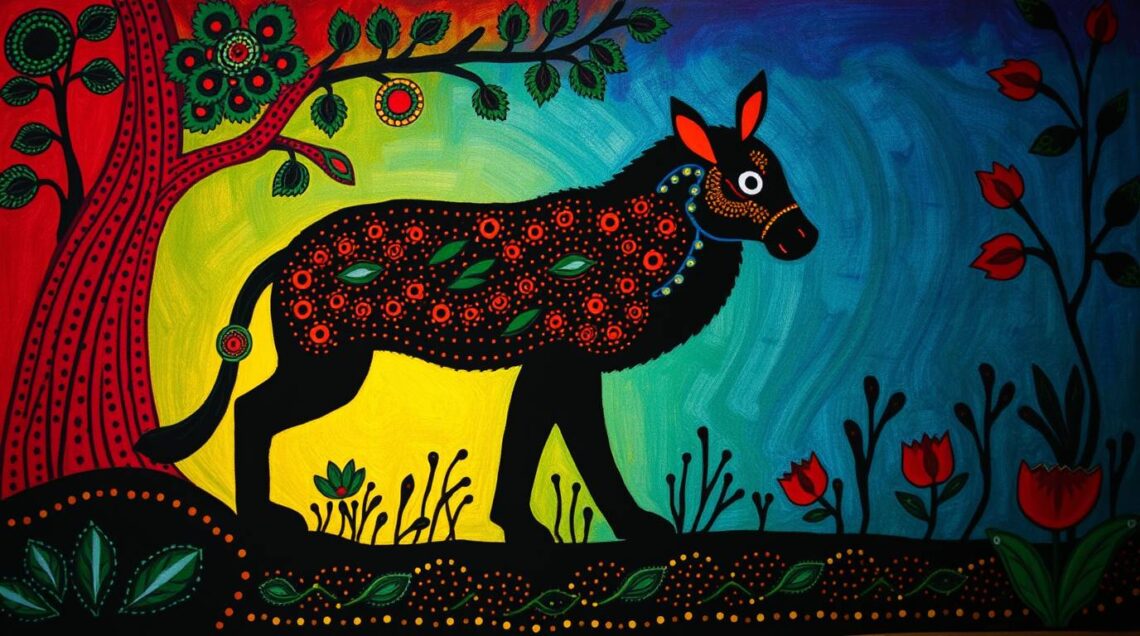
Gond Art Painting: From Tribal Walls to Contemporary Canvases
A scintillating form of indigenous expression is gond art painting, which traces its roots to the Gond tribe of central India. Gond art is known for its bright colors, intricate designs, and its motifs, which tend to be drawn from nature. But more than just an art that delights the eyes, bypassing myths, folklore, and the collective memory of people, Gond art is a form of storytelling—the very nature of which is captivating.
Art has often been described as the mirror of a society. In India, as is the case with tribal art, one vital element has always been the relationship between the people, nature, and delving into spirituality. The sole fact that gond art painting art is done using bright colors and intricate designs is just the start. It has a far deeper importance.
Gond tribal painting is so exquisite as a form of the indigenous art of painting that even modern sophisticated people appreciate gond painting. Gond painting has been said to have its own identity and tradition has advanced. It has roots that are humble as tribal walls, but now has a contemporary global recognition center.
A purpose of this article to delve deeply into an area of gond art that has been overlooked: the history, features, challenges, cultural importance, and changing modern adaptations of gond art painting. It is quite simple to comprehend its immense worth as a folk art of India.
Gond Art History
The Gonds constitute the largest tribal population in India, predominantly located in the regions of Madhya Pradesh, Chhattisgarh, Maharashtra and Odisha. It is said that the word “Gond” comes from the Dravidian word “Kond” which means a hill, showing their habitation in hilly, forested regions.
Gond people used to adorn the mud walls and floors of their huts with paintings and murals during certain rituals, festivals, or during other significant family events. These murals served a spiritual and protective function, wards off evil and brings prosperity to the households.
In the 1980s, the transition of Gond art from walls to paper and canvas was art of the shift toward the contemporary. This shift in art was lead by Venkat Singh Shyam whose work was pioneering and resonated throughout the globe. Venkat Singh Shyam is known for his “out of the box” thinking in art. This transition is said to have brought gond handmade art painting to urban and global audiences expanding from local rituals to contemporary fine arts.
Features of Gond Art Painting
1. Linework and dots
The joyous movement of Gond paintings is often acclaimed to the rhythmic patterns of lines, dots, and dashes that fill the figures and anchor the composition.
2. Exuberant Colors
At first, artists derived colors from soil, vegetables, and charcoals. In current times, artists are more likely to use acrylics, making modern gond handmade art paintings more radiant, exceptional, and flexible.
3. Nature-Centric Subjects
Gond paintings are filled with trees, animals, birds, rivers, and heavenly bodies. Nature is very important to the Gonds, and they demonstrate this in their art by attaching spiritual significance to the beautiful fauna and flora.
4. Storytelling Art
Like any art form, storytelling is a huge component of the art form. Each of the paintings features a story, a fable, or a legend derived from the mundane routines of the tribe. For instance, a tree painting may depict the ‘Tree of Life’ which, in this case, represents creation and sustenance.
5. Symbolism
Every motif is an embodiment of a story in itself, a tiger is a symbol of strength, a fish is a symbol of fertility, and birds of harmony. This makes Gond art more profound and culturally rich.
Social and Cultural Impact
To the Gond community, painting transcends being an art form and integrates itself to identity and culture.
- Spiritual Impact: The ritualistic practices associated with Gond art of a protective nature are also significant.
- Preservation of Oral Histories: Art became the medium to convey and preserve folklore and myths due to the absence of a written script.
- Community Cohesion: Festival events bonding deepens relationships.
- Cultural Identity: Gond art has remained relevant at tribal expression in contemporary times.
Therefore it can be said that gond art painting is a form of art and a preserving asset of Gond people culture.
Gond Art In Contemporary Times
From Walls To Canvas
The change that enhanced the reach of Gond artists the most was the ability to create on paper and canvas. This change empowered the artists to sell their work beyond the boundaries of their villages and sell to urban households, galleries and even participate in international exhibitions.
Global Reach
Today, gond paintings are included in several prestigious museums across the world. For instance, the works of Venkat Singh Shyam at the Centre Pompidou in Paris bought worldwide attention to the art, and so he has become a bridge to let the world know gond paintings.
Contemporary Uses
It is in the contemporary times that gond designs are incorporated in:
- Fashion: Gonds motifs on sarees, scarves and other accessories.
- Home Decor: Spiral motifs on wall murals and other home accessories like furniture and ceramics.
- Children Literature: Gond patterned art to illustrate folk tales.
- Digital Art: Gonds designs to create wallpapers, websites and even NFTs.
Because of this, handmade art painting ensures that its tribal fundamental values are preserved despite the changes.
Advantages of Gond Art Painting
- Cultural Preservation – Protects tribal stories and folklore.
- Economic Empowerment – Creates several job opportunities for tribal artists.
- Global Appreciation – Promotes indigenous Indian art at international levels.
- Environmental Awareness – Promote respect for nature with an emphasis on its appreciation.
- Mindfulness and Therapy – Gond’s rhythmic patterns in art calm the mind and induce trance-like states.
Gond Art Challenges
Gond art’s new-found fame and popularity have not come without a few downsides:
- Commercialization: An unbalanced distribution of payment often emerges within the exploitation of an art movement.
- Imitations: The genuine value of tribal Gond art paintings is undermined by hordes of mass-produced Gond art prints.
- Erasure of Tradition: The delicate nature of storytelling interwoven with over-commercialized art runs the risk of disappearance completely.
- Material Scarcity: The sustained desire and need for traditional natural pigments is on the rise while its access is declining.
- Cultural Appreciation Deficit: The deeper meanings and value behind Gond art serve only as a secondary and less important appreciation – a mere decorative piece.
Ways to Support and Appreciate Gond Art
- Buy Authentic Works: Go to workshops and certified worker cooperatives to buy art directly from Gond artists.
- Know the Stories: Understand the meanings of the motifs behind the paintings.
- Advocacy for Education: Promote the inclusion of Gond art in school curricula and other educational creative endeavors.
- Eco-friendly Guidelines: Support the Gond art movement for eco-friendly natural pigments.
- Global Awareness: Promote the artwork for artists to be seen beyond India utilizing social media.
The Position of Gond Tribal Art Painting
The innovations combined with the desire and need to preserve Gond art ensure its future is bright.
- Digital Features: Online galleries combined with NFTs to expand the reach of Gond art.
- Cooperation: Foster interconnection with fashion routes for architectural structures and space designing and related partnerships.
- Eco-Friendly Cultivation Practices: Bringing back natural pigments for stewardship.
- International Exhibitions: Increasing appreciation for world artistic domains.
- Youth Involvement: Newer cohorts of Gond artists provide new insights.
These trends will guarantee that gond art painting continues to be a dynamic and changing custom.
Conclusion
Gond art painting has been an outstanding transformation from tribal and mud wall relics to art gallery shows in a romanticized version of its nature. Capturing its spiritual elements and extensive storytelling paired with its primal core, it is astounding how gond art painting translates to modern mediums in a harmonious manner.
Gond handmade art painting today is a folk art taken to a new high and is appreciated around the world. In compliment to its past and heritage, supporting artists who we believe to be authentic also is required.
Tribal gond art painting has a unique and outstanding way of depicting nature and the connection we humans have with it. The art is created with such elegance that it demonstrates the unquestionable link we have with our identity, myths, and the pure essence of nature.
You May Also Like

How to Embed Vimeo Video on Webflow
March 31,
CocoLoan Review: The Best Service Of Unemployment Payday Loans In The US
December 30,


